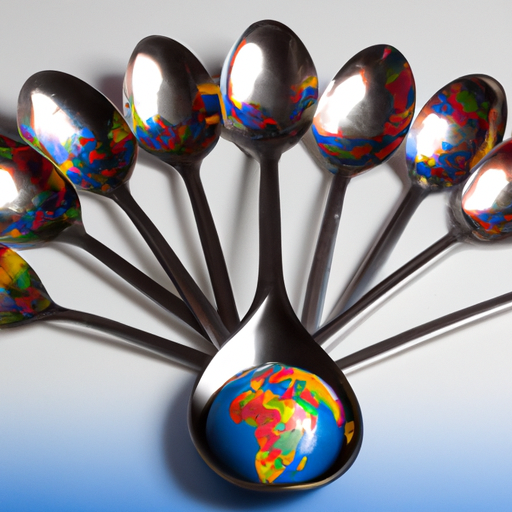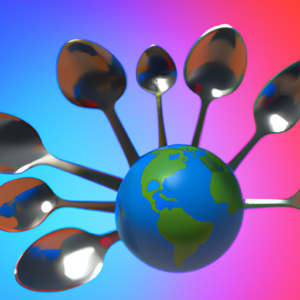
Traveling with Spoons: Exploring Global Spoon Traditions and Culinary Delights
“Taste the World with Traveling with Spoons – Discovering Global Spoon Traditions and Culinary Delights!”
Introduction
This article is dedicated to exploring the fascinating world of spoons and their unique cultural and culinary significance around the world. From the traditional wooden spoons of Japan to the ornate silver spoons of Europe, we will explore the history, symbolism, and culinary uses of spoons from different cultures. We will also explore the many delicious dishes that can be made with spoons, from soups to desserts. So join us on this journey as we explore the fascinating world of spoons and their culinary delights!
Exploring Spoon Traditions Around the World: A Journey Through Global Culinary Delights

Welcome to a journey around the world, exploring the unique and fascinating spoon traditions that have been passed down through generations. From the ancient Chinese chopsticks to the traditional African wooden spoon, each culture has its own unique way of eating and enjoying food.
In China, chopsticks are the traditional utensil of choice. They are believed to have been invented over 4,000 years ago and are still used today. Chopsticks are used to pick up food and to mix ingredients together. They are also used to measure out portions of food, as well as to scoop up sauces and other liquids.
In India, the traditional spoon is the thali. This is a round metal plate with several small bowls or compartments. The thali is used to serve a variety of dishes, such as curries, rice, and vegetables. The thali is also used to scoop up food and to mix ingredients together.
In Africa, the traditional spoon is the wooden spoon. This is a long, thin spoon made from wood. It is used to scoop up food and to mix ingredients together. The wooden spoon is also used to measure out portions of food, as well as to scoop up sauces and other liquids.
In Japan, the traditional spoon is the hashi. This is a small, flat spoon made from bamboo. It is used to pick up food and to mix ingredients together. The hashi is also used to measure out portions of food, as well as to scoop up sauces and other liquids.
In Mexico, the traditional spoon is the cuchara. This is a large, flat spoon made from wood. It is used to scoop up food and to mix ingredients together. The cuchara is also used to measure out portions of food, as well as to scoop up sauces and other liquids.
No matter where you go in the world, you will find unique and fascinating spoon traditions. Each culture has its own way of eating and enjoying food, and each spoon has its own special purpose. So take a journey around the world and explore the unique and fascinating spoon traditions that have been passed down through generations. Bon voyage!
Discovering Spoon Rituals and Customs: Experiencing the Cultural Significance of Spoons Across Cultures
Spoons are one of the most common utensils used in everyday life, but did you know that they have a rich history and cultural significance across many cultures? From ancient rituals to modern customs, spoons have been used in a variety of ways to mark special occasions, honor traditions, and even bring good luck. In this blog post, we’ll explore some of the fascinating spoon rituals and customs from around the world.
In Japan, spoons are used in a traditional tea ceremony known as chanoyu. During this ceremony, the host will use a special spoon to scoop powdered green tea into a bowl and then whisk it with hot water. This ritual is meant to bring peace and harmony to the participants and is a sign of respect and hospitality.
In India, spoons are used in a ritual known as aarti. During this ceremony, a spoon is used to light a lamp and then waved in a circular motion around the flame. This is done to honor the gods and bring good luck.
In the Philippines, spoons are used in a traditional wedding ceremony known as the “coin ceremony.” During this ceremony, the bride and groom exchange coins and then use spoons to scoop up the coins and place them in a bowl. This is meant to symbolize the couple’s commitment to each other and their shared future.
In many cultures, spoons are also used to mark special occasions. In some parts of Europe, spoons are given as gifts to mark a baby’s birth or a wedding. In some parts of Africa, spoons are used to bless a new home or business.
Spoons are also used in many superstitious rituals. In some parts of Europe, spoons are placed under the pillow to ward off bad dreams. In some parts of Asia, spoons are placed in the corners of a room to bring good luck.
No matter where you are in the world, spoons have a special place in many cultures. From ancient rituals to modern customs, spoons are a symbol of hospitality, respect, and good luck. So the next time you use a spoon, take a moment to appreciate its cultural significance and the many ways it has been used throughout history.
Conclusion
Traveling with Spoons is an excellent article for anyone interested in exploring global spoon traditions and culinary delights. It provides a comprehensive overview of the history and culture of spoons, as well as a variety of recipes from around the world. Whether you are looking to learn more about the history of spoons or to try out some new recipes, this book is sure to provide you with an enjoyable and educational experience.

